Microstructure of Bio-Based Building Materials: New Insights into the Hysteresis Phenomenon and Its Consequences
Abstract
1. Introduction
2. Focus on Bio-Based Building Materials and Their Specificities
2.1. Microstructure
2.2. Hygroscopic Properties
2.3. Chemical Composition
2.4. Swelling and Shrinkage
2.5. Functional Properties with Age
2.6. Temperature Effects
2.7. Local Kinetic Sorption
2.8. Sorption Hysteresis
- The sorption mechanism is reversible since the original state is obtained at a dry state [57].
- Aging reduces the rate of adsorption and desorption for hemp concrete [59].
- Hysteresis increases, whereas crystallinity decreases [60].
- Water content is always higher in the desorption than in the adsorption phase for the same relative humidity.
3. From Hydrogen Bonding to Hysteresis
3.1. Hydrogen Bonding
3.2. Microscopic Understanding of Hysteresis
- Intermolecular hydrogen bonds between water molecules (HBWW);
- Intermolecular hydrogen bond between water molecules and cellulose (HBCW);
- Inter-chain hydrogen bonds in cellulose (HBCC).
4. Discussion: New Insights into Hysteresis in Bio-Sourced Materials
4.1. A Necessary New Approach
4.2. Hysteresis: From the Aggregate Scale to the Material One
- (i)
- A new water fixation mechanism
- Area 1: Water fixation on a pore surface is relatively fast because the host sites are easily accessible: HBCW bonds form on polymer surface chains or in pores of an amorphous region, and then HBWW form easily until the initial pores are filled.
- Area 2: Polymer chains open up, freeing new host sites to create HBCW bonds. In parallel, HBCC bonds break.
- Area 3: At high relative humidity, hydrogen bonds mostly form between water molecules because many host sites are occupied on polymer chains. This leads to water clusters in the new pore spaces created by the swelling of the polymer chains. Because host sites are very accessible, the associated kinetics are quite fast, as in area 1.
- (ii)
- A new description of hysteresis
4.3. Experimental Measurments
- (i)
- Protocol
- (ii)
- Dimension comparison
4.4. Macroscopic Effects
5. Conclusions
Author Contributions
Funding
Data Availability Statement
Conflicts of Interest
References
- Lagouin, M.; Magniont, C.; Sénéchal, P.; Moonen, P.; Aubert, J.-E.; Laborel-préneron, A. Influence of types of binder and plant aggregates on hygrothermal and mechanical properties of vegetal concretes. Constr. Build. Mater. 2019, 222, 852–871. [Google Scholar] [CrossRef]
- Maaroufi, M.; Bennai, F.; Belarbi, R.; Abahri, K. Experimental and numerical highlighting of water vapor sorption hysteresis in the coupled heat and moisture transfers. J. Build. Eng. 2021, 40, 102321. [Google Scholar] [CrossRef]
- Issaadi, N. Effets De La Variabilité Des Propriétés De Matériaux Cimentaires Sur Les Transferts Hygrothermiques: Développement D’une Approche Probabiliste. Ph.D. Thesis, Laboratoire des Sciences de l’Ingénieur Pour l’Environnement, La Rochelle, France, 2015. [Google Scholar]
- Bennai, F.; El Hachem, C.; Abahri, K.; Belarbi, R. Microscopic hydric characterization of hemp concrete by X-ray microtomography and digital volume correlation. Constr. Build. Mater. 2018, 188, 983–994. [Google Scholar] [CrossRef]
- Laborel-Préneron, A.; Magniont, C.; Aubert, J.-E. Characterization of Barley Straw, Hemp Shiv and Corn Cob as Resources for Bioaggregate Based Building Materials. Waste Biomass Valoriz. 2018, 9, 1095–1112. [Google Scholar] [CrossRef]
- Aït Oumeziane, Y.; Moissette, S.; Bart, M.; Lanos, C. Influence of temperature on sorption process in hemp concrete. Constr. Build. Mater. 2016, 106, 600–607. [Google Scholar] [CrossRef]
- Chen, M.; Coasne, B.; Guyer, R.; Derome, D.; Carmeliet, J. Role of hydrogen bonding in hysteresis observed in sorption-induced swelling of soft nanoporous polymers. Nat. Commun. 2018, 9, 3507. [Google Scholar] [CrossRef]
- Jami, T.; Karade, S.R.; Singh, L.P. A review of the properties of hemp concrete for green building applications. J. Clean. Prod. 2019, 239, 117852. [Google Scholar] [CrossRef]
- Delannoy, G.; Marceau, S.; Glé, P.; Gourlay, E.; Guéguen-Minerbe, M.; Diafi, D.; Nour, I.; Amziane, S.; Farcas, F. Performances des bétons de chanvre: Des propriétés microscopiques aux propriétés fonctionnelles. Acad. J. Civ. Eng. 2017, 35, 194–197. [Google Scholar] [CrossRef]
- Abbas, M.S.; Gourdon, E.; Glé, P.; McGregor, F.; Ferroukhi, M.Y.; Fabbri, A. Relationship between hygrothermal and acoustical behavior of hemp and sunflower composites. Build. Environ. 2021, 188, 107462. [Google Scholar] [CrossRef]
- Collet, F.; Chamoin, J.; Pretot, S.; Lanos, C. Comparison of the hygric behaviour of three hemp concretes. Energy Build. 2013, 62, 294–303. [Google Scholar] [CrossRef]
- Ratsimbazafy, H.H.; Laborel-Preneron, A.; Magniont, C.; Evon, P. A review of the multi-physical characteristics of plant aggregates and their effects on the properties of plant-based concrete. Recent Prog. Mater. 2021, 3, 2. [Google Scholar] [CrossRef]
- Maaroufi, M. Modélisation Des Transferts Hygrothermiques Dans Les Matériaux De Construction: Incidence de L’hystérésis. Ph.D. Thesis, Laboratoire des Sciences de l’Ingénieur Pour l’Environnement, La Rochelle, France, 2019. [Google Scholar]
- Mazhoud, B.; Collet, F.; Prétot, S.; Lanos, C. Effect of hemp content and clay stabilization on hygric and thermal properties of hemp-clay composites. Constr. Build. Mater. 2021, 300, 123878. [Google Scholar] [CrossRef]
- Babaee, M.; Castel, A. Water vapor sorption isotherms, pore structure, and moisture transport characteristics of alkali-activated and Portland cement-based binders. Cem. Concr. Res. 2018, 113, 99–120. [Google Scholar] [CrossRef]
- Promis, G.; Freitas Dutra, L.; Douzane, O.; Tran Le, A.D.; Langlet, T. Temperature-dependent sorption models for mass transfer throughout bio-based building materials. Constr. Build. Mater. 2019, 197, 513–525. [Google Scholar] [CrossRef]
- Collet, F. Caracterisation Hydrique Et Thermique De Materiaux De Genie Civil A Faibles Impacts Environnementaux. Ph.D. Thesis, L’institut National des Sciences Appliquées de Rennes, Rennes, France, 2004. [Google Scholar]
- Magniont, C. Contribution à la Formulation et à la Caractérisation d’un Écomatériau de Construction à Base D’agroressources. Ph.D. Thesis, University of Toulouse III-Paul Sabatier, Toulouse, France, 2010. [Google Scholar]
- Le Troëdec, M.; Rachini, A.; Peyratout, C.; Rossignol, S.; Max, E.; Kaftan, O.; Fery, A.; Smith, A. Influence of chemical treatments on adhesion properties of hemp fibres. J. Colloid Interface Sci. 2011, 356, 303–310. [Google Scholar] [CrossRef] [PubMed]
- Benmahiddine, F. Études des Transferts Couplés de Chaleur, D’air et D’humidité par des Techniques de Changement D’échelle (Microscopique-Macroscopique): Application à L’évaluation de la Performance Énergétique et la Durabilité Des Matériaux de Construction. Ph.D. Thesis, Laboratoire des Sciences de l’Ingénieur Pour l’Environnement, La Rochelle, France, 2020. [Google Scholar]
- Lagouin, M. Caractérisation et Optimisation Multiphysiques D’une Paroi Bicouche bio et Géosourcée. Ph.D. Thesis, University of Toulouse III-Paul Sabatier, Toulouse, France, 2020. [Google Scholar]
- Magniont, C.; Escadeillas, G. Chemical Composition of Bio-aggregates and Their Interactions with Mineral Binders. In Bio-Aggregates Based Building Materials: State-of-the-Art Report of the RILEM Technical Committee 236-BBM; Amziane, S., Collet, F., Eds.; RILEM State-of-the-Art Reports; Springer: Dordrecht, The Netherlands, 2017; pp. 1–37. ISBN 978-94-024-1031-0. [Google Scholar]
- Ratsimbazafy, H.H.; Laborel-Preneron, A.; Magniont, C.; Evon, P. Comprehensive Characterization of Agricultural By-Products for Bio-Aggregate Based Concrete. Constr. Technol. Archit. 2022, 1, 77–84. [Google Scholar]
- Stevulova, N.; Cigasova, J.; Schwarzova, I.; Sicakova, A.; Junak, J. Sustainable Bio-Aggregate-Based Composites Containing Hemp Hurds and Alternative Binder. Buildings 2018, 8, 25. [Google Scholar] [CrossRef]
- Amziane, S.; Collet, F. Bio-Aggregates Based Building Materials: State-of-the-Art Report of the RILEM Technical Committee 236-BBM; Springer: Berlin/Heidelberg, Germany, 2017; ISBN 978-94-024-1031-0. [Google Scholar]
- Dujardin, N. Un Materiau Biosource de Choix: Les Fibres Naturelles. In Caractérisations et applications. In Proceedings of the 25th Journées Scientifiques de l’Environnement-L’économie Verte en Question, Créteil, France, 18 February 2014. [Google Scholar]
- Gehring, F. Étude du Comportement Mécanique et de L’endommagement de Composites Thermoplastiques Renforcés de Fibres Courtes de Chanvre: Approche Expérimentale et Modélisation; Université de Lorraine: Nancy, France, 2013. [Google Scholar]
- Gardner, K.H.; Blackwell, J. The hydrogen bonding in native cellulose. Biochim. Biophys. Acta BBA-Gen. Subj. 1974, 343, 232–237. [Google Scholar] [CrossRef]
- Perez, S. Structure et Morphologie de la Cellulose. 2000. Available online: https://www.researchgate.net/publication/281877184_Structure_et_morphologie_de_la_cellulose (accessed on 12 April 2023).
- Teeri, T.T. Crystalline cellulose degradation: New insight into the function of cellobiohydrolases. Trends Biotechnol. 1997, 15, 160–167. [Google Scholar] [CrossRef]
- Sofiane, A.; Laurent, A. Les Bétons de Granulats D’origine Végétale: Application au Béton de Chanvre; Lavoisier: Paris, France, 2013; ISBN 978-2-7462-8809-6. [Google Scholar]
- Mitra, G.B.; Mukherjee, P.S. X-ray diffraction study of fibrous polymers. I. Degree of paracrystallinity—A new parameter for characterizing fibrous polymers. Polymer 1980, 21, 1403–1409. [Google Scholar] [CrossRef]
- Frollini, E.; Leao, A.; Mattoso, L.; Rowell, R.; Han, J.; Rowell, J. Characterization and Factors Effecting Fiber Properties. Nat. Polym. Agrofibers Compos. 2000. [Google Scholar]
- Rebiere, J. Nouvelle Méthodologie Pour la Caractérisation de Distributions de Masses Molaires D’échantillons Cellulosiques Complexes; Institut National Polytechnique: Toulouse, France, 2017. [Google Scholar]
- Pinkert, A.; Marsh, K.; Pang, S.; Staiger, M. Ionic Liquids and Their Interaction with Cellulose. Chem. Rev. 2009, 109, 6712–6728. [Google Scholar] [CrossRef] [PubMed]
- Rabideau, B.D.; Ismail, A.E. Mechanisms of hydrogen bond formation between ionic liquids and cellulose and the influence of water content. Phys. Chem. Chem. Phys. 2015, 17, 5767–5775. [Google Scholar] [CrossRef] [PubMed]
- Troncoso, V.; Kouta, N.; Escadeillas, G.; Barragan, V.H.G. Réactivité Des Cendres Volcaniques Équatoriennes Dans Les Liants Minéraux. 2022. Available online: https://hal.science/hal-03879708 (accessed on 12 April 2023).
- Chabannes, M.; Nozahic, V.; Amziane, S. Design and multi-physical properties of a new insulating concrete using sunflower stem aggregates and eco-friendly binders. Mater. Struct. 2015, 48, 1815–1829. [Google Scholar] [CrossRef]
- Ouedraogo, K.A.J. Stabilisation de Matériaux de Construction Durables et Écologiques à Base de Terre Crue Par Des Liants organiques et/ou Minéraux à Faibles Impacts Environnementaux. Ph.D. Thesis, University of Toulouse III-Paul Sabatier, Toulouse, France, 2019. [Google Scholar]
- Guide des Bonnes Pratiques de la Construction en Terre Crue. Available online: https://www.rehabilitation-bati-ancien.fr/espace-documentaire/guide-des-bonnes-pratiques-la-construction-en-terre-crue (accessed on 12 April 2023).
- Garcia-Boivin, S. Retrait au Jeune Age du Beton: Developpement D’une Methode Experimentale et Contribution a L’analyse Physique du Retrait Endogene. 1999. Available online: https://trid.trb.org/view/960738 (accessed on 12 April 2023).
- Matthieu, M.S. Potentiel des Fibres Végétales Courtes Dans L’amélioration du Comportement Mécanique des Mortiers. Ph.D. Thesis, INSA de Toulouse, Toulouse, France, 2022. [Google Scholar]
- Achour, C.; Remond, S.; Belayachi, N. Mesure du gonflement-retrait des granulats végétaux par analyse d’image. Acad. J. Civ. Eng. 2022, 40, 104–107. [Google Scholar] [CrossRef]
- Marceau, S.; Glé, P.; Gourlay, E.; Gueguen-Minerbe, M.; Delannoy, G.; Amziane, S.; Farcas, F. Impact de vieillissements accélérés sur les propriétés de bétons de chanvre. Acad. J. Civ. Eng. 2016, 34, 712–719. [Google Scholar] [CrossRef]
- Delannoy, G. Durabilité du béton de chanvre soumis à des cycles d’humidification-séchage. Acad. J. Civ. Eng. 2018, 36, 400–407. [Google Scholar] [CrossRef]
- Benmahiddine, F.; Bennai, F.; Cherif, R.; Belarbi, R.; Tahakourt, A.; Abahri, K. Experimental investigation on the influence of immersion/drying cycles on the hygrothermal and mechanical properties of hemp concrete. J. Build. Eng. 2020, 32, 101758. [Google Scholar] [CrossRef]
- Delannoy, G.; Marceau, S.; Glé, P.; Gourlay, E.; Guéguen-Minerbe, M.; Amziane, S.; Farcas, F. Durability of hemp concretes exposed to accelerated environmental aging. Constr. Build. Mater. 2020, 252, 119043. [Google Scholar] [CrossRef]
- Bourdot, A.; Moussa, T.; Gacoin, A.; Maalouf, C.; Vazquez, P.; Thomachot-Schneider, C.; Bliard, C.; Merabtine, A.; Lachi, M.; Douzane, O.; et al. Characterization of a hemp-based agro-material: Influence of starch ratio and hemp shive size on physical, mechanical, and hygrothermal properties. Energy Build. 2017, 153, 501–512. [Google Scholar] [CrossRef]
- Rode, C.; Clorius, C.O. Modeling of Moisture Transport in Wood with Hysteresis and Temperature-Dependent Sorption Characteristics. Available online: https://web.ornl.gov/sci/buildings/conf-archive/2004%20B9%20papers/154_Rode.pdf (accessed on 12 April 2023).
- Le, A.D.T.; Samri, D.; Rahim, M.; Douzane, O.; Promis, G.; Langlet, T. Effect of Temperature-dependent Sorption Characteristics on The Hygrothermal Behavior of Hemp Concrete. Energy Procedia 2015, 78, 1449–1454. [Google Scholar] [CrossRef]
- Reuge, N.; Moissette, S.; Bart, M.; Collet, F.; Lanos, C. Modèle de cinétique locale de sorption couplé au phénomène d’hystérésis pour les matériaux biosourcés. Acad. J. Civ. Eng. 2018, 36, 43–46. [Google Scholar] [CrossRef]
- Reuge, N.; Collet, F.; Pretot, S.; Moissette, S.; Bart, M.; Lanos, C. Cinétique locale de sorption: Modélisation d’une paroi biosourcée. Acad. J. Civ. Eng. 2021, 38. [Google Scholar] [CrossRef]
- Yacine, A.O.; Bart, M.; Moissette, S.; Lanos, C.; Collet, F.; Pretot, S. Hysteresis phenomenon in hemp concrete. In Proceedings of the First International Conference on Bio-based Building Materials, Clermont-Ferrand, France, 22–24 June 2015. [Google Scholar]
- Nouri, M. Développement D’éléments en Biocomposite à Base de Fibre Végétale Pour la Réhabilitation Énergétique des Bâtiments. Ph.D. Thesis, Ecole centrale de Nantes, Nantes, France, 2020. [Google Scholar]
- Abbas, M.S. Caractérisations Multi-Physiques Des Mortiers Bio-Sourcés Isolants et Modélisation de Leurs Impacts Sur Les Transferts Hygrothermiques à L’échelle des Parois: Application Aux Bétons de Moelles Végétales. Ph.D. Thesis, Laboratoire de Tribologie et Dynamique des Systèmes, Lyon, France, 2021. [Google Scholar]
- Lelièvre, D. Simulation Numérique Des Transferts De Chaleur Et D’humidité Dans Une Paroi Multicouche De Bâtiment En Matériaux Biosourcés. Ph.D. Thesis, Université de Bretagne Sud, Lorient, France, 2015. [Google Scholar]
- Maalouf, C.; Moussa, T.; Umurigirwa, B.S.; Mai, T.H. Etude Des Isothermes De Sorption D’un Agromatériau À Base De Chanvre-Amidon. Available online: https://www.sft.asso.fr/Local/sft/dir/user-3775/documents/actes/Congres_2015/Communications/38383-fichier4.pdf (accessed on 12 April 2023).
- Abbas, M.S.; McGregor, F.; Fabbri, A.; Ferroukhi, M.Y. The use of pith in the formulation of lightweight bio-based composites: Impact on mechanical and hygrothermal properties. Constr. Build. Mater. 2020, 259, 120573. [Google Scholar] [CrossRef]
- Bennai, F.; Issaadi, N.; Abahri, K.; Belarbi, R.; Tahakourt, A. Experimental characterization of thermal and hygric properties of hemp concrete with consideration of the material age evolution. Heat Mass Transf. 2018, 54, 1189–1197. [Google Scholar] [CrossRef]
- Bhouri, N. Comportement Thermodynamique Et Dimensionnel Des Matériaux Textiles Soumis À Des Variations Des Conditions Climatiques. Ph.D. Thesis, Laboratoire d’Etude et de Recherche sur le Matériau Bois, Nancy, France, 2009. [Google Scholar]
- Fabbri, A.; McGregor, F. Impact of the determination of the sorption-desorption curves on the prediction of the hemp concrete hygrothermal behaviour. Constr. Build. Mater. 2017, 157, 108–116. [Google Scholar] [CrossRef]
- Soudani, L. Modelling and Experimental Validation of the Hygrothermal Performances of Earth as A Building Material. Ph.D. Thesis, Laboratoire de Tribologie et Dynamique des Systèmes, Lyon, France, 2016. [Google Scholar]
- Champiré, F. Étude expérimentale du comportement hydro-mécanique de la terre crue compactée pour la construction. Ph.D. Thesis, Université de Lyon, Lyon, France, 2017. [Google Scholar]
- Zhang, Z. Modelling Of Sorption Hysteresis and Its Effect on Moisture Transport within Cementitious Materials. Ph.D. Thesis, Université Paris-Est, Créteil, France, 2014. [Google Scholar]
- Oumeziane, Y.A. Evaluation Des Performances Hygrothermiques D’une Paroi Par Simulation Numérique: Application Aux Parois En Béton De Chanvre. Ph.D. Thesis, INSA de Rennes, Rennes, France, 2013. [Google Scholar]
- Derluyn, H.; Derome, D.; Carmeliet, J.; Stora, E.; Barbarulo, R. Hysteretic moisture behavior of concrete: Modeling and analysis. Cem. Concr. Res. 2012, 42, 1379–1388. [Google Scholar] [CrossRef]
- Cavillon, F. Caractérisation De La Liaison Hydrogène Dans Des Systèmes Moléculaires D’intérêt Biologique Par Diffusion De Neutrons. Ph.D. Thesis, Université des Sciences et Technologie de Lille-Lille I, Villeneuve-d’Ascq, France, 2004. [Google Scholar]
- Steiner, T.; Desiraju, G.R. Distinction between the weak hydrogen bond and the van der Waals interaction. Chem. Commun. 1998, 891–892. [Google Scholar] [CrossRef]
- Buckingham, A.D.; Del Bene, J.E.; McDowell, S.A.C. The hydrogen bond. Chem. Phys. Lett. 2008, 463, 1–10. [Google Scholar] [CrossRef]
- Spinu, M. Evaluation Des Paramètres Physiques Et Physico-Chimiques Qui Influencent L’accessibilité De La Cellulose. Ph.D. Thesis, École Nationale Supérieure des Mines de Paris, Paris, France, 2010. [Google Scholar]
- Mouchaham, G. Architectures Supramoléculaires À Structures Ouvertes Fondées Sur La Liaison Hydrogène: Élaboration, Caractérisation Structurale Et Propriétés De Sorption. Ph.D. Thesis, Toulouse 3, Toulouse, France, 2012. [Google Scholar]
- Kannam, S.K.; Oehme, D.P.; Doblin, M.S.; Gidley, M.J.; Bacic, A.; Downton, M.T. Hydrogen bonds and twist in cellulose microfibrils. Carbohydr. Polym. 2017, 175, 433–439. [Google Scholar] [CrossRef]
- Ratsimbazafy, H.H. Évaluation Du Potentiel De Co-Produits Agricoles Locaux Valorisables Dans Le Domaine Des Matériaux De Construction (Palomac). Ph.D. Thesis, Toulouse 3, Toulouse, France, 2022. [Google Scholar]
- Engelund, E.T.; Thygesen, L.G.; Svensson, S.; Hill, C.A.S. A critical discussion of the physics of wood–water interactions. Wood Sci. Technol. 2013, 47, 141–161. [Google Scholar] [CrossRef]

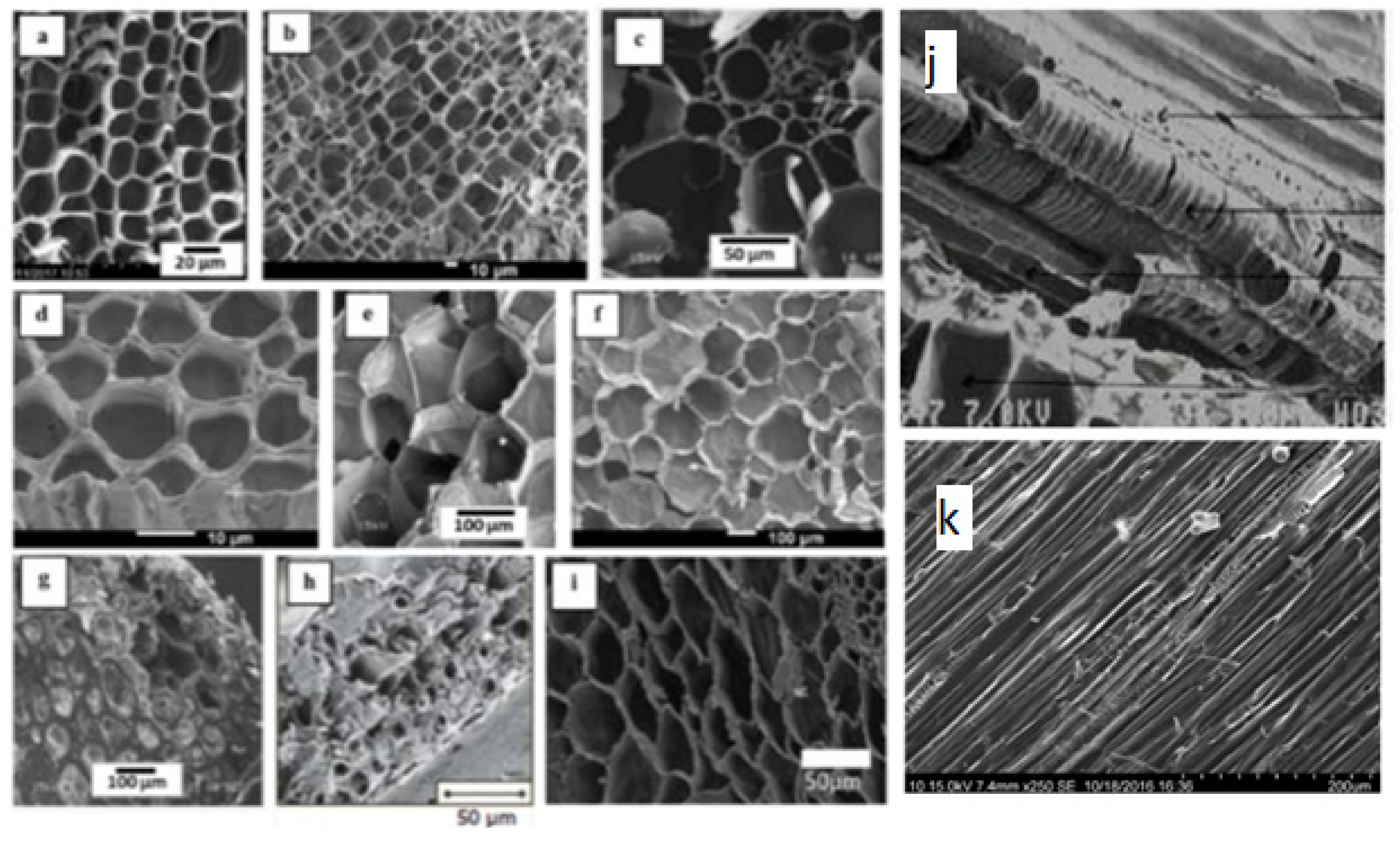
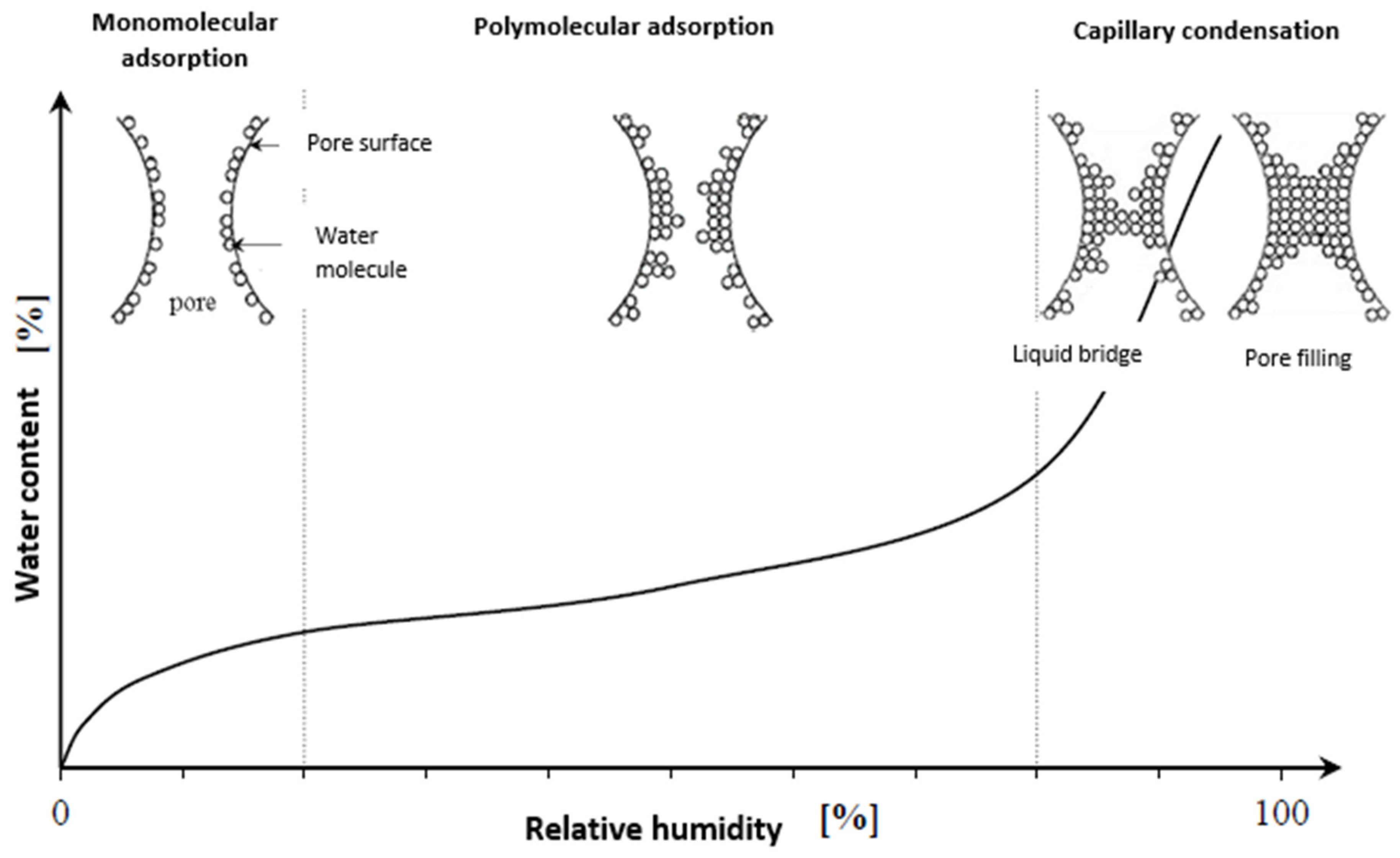
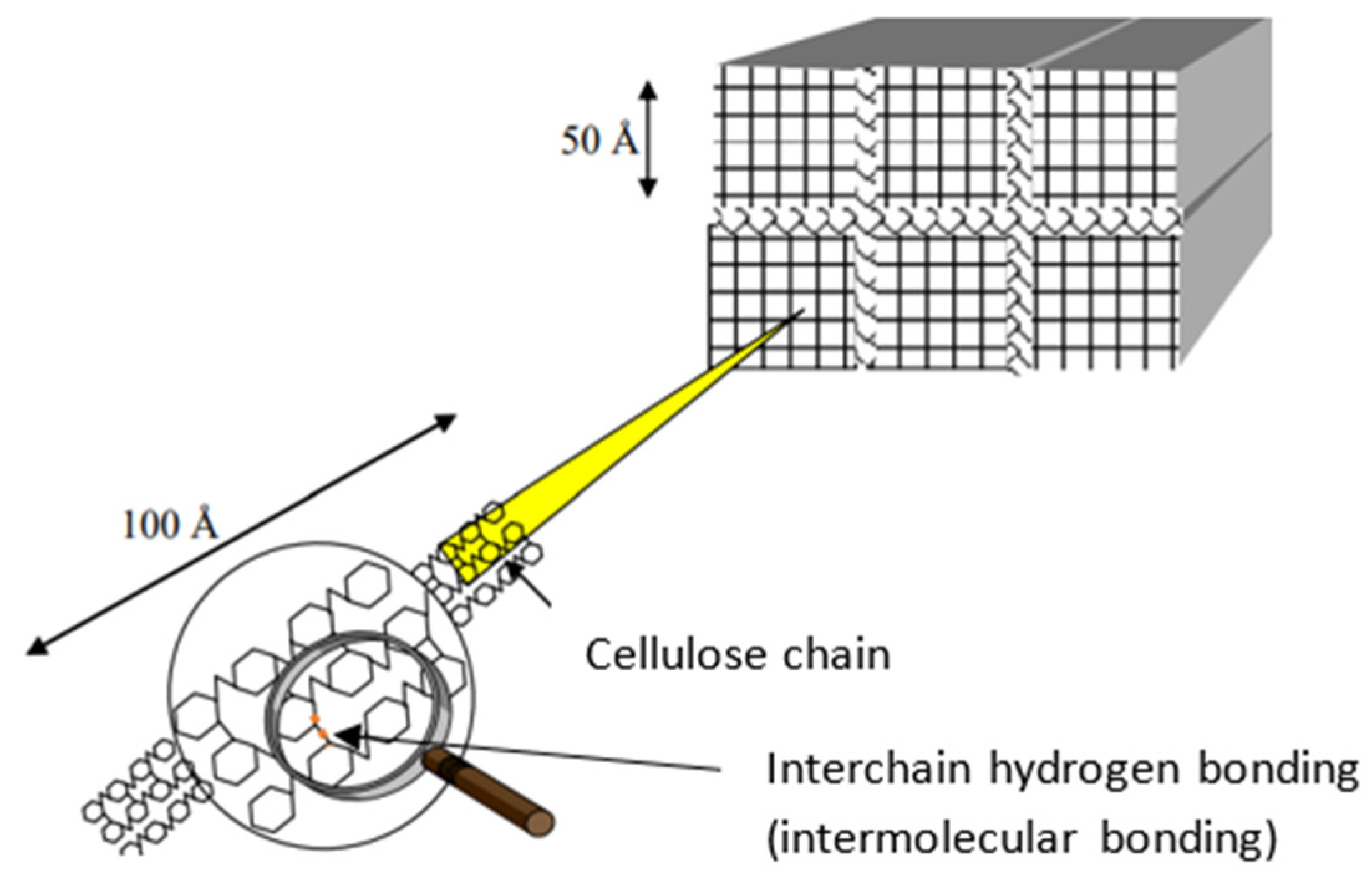
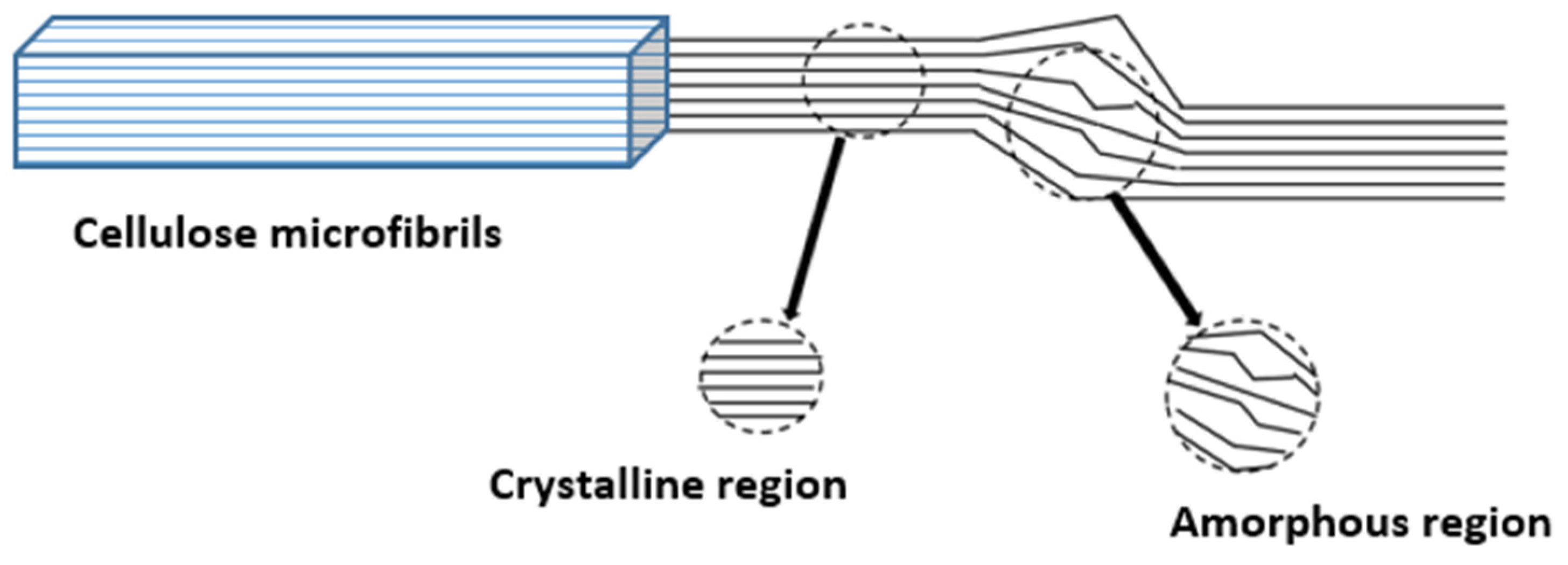

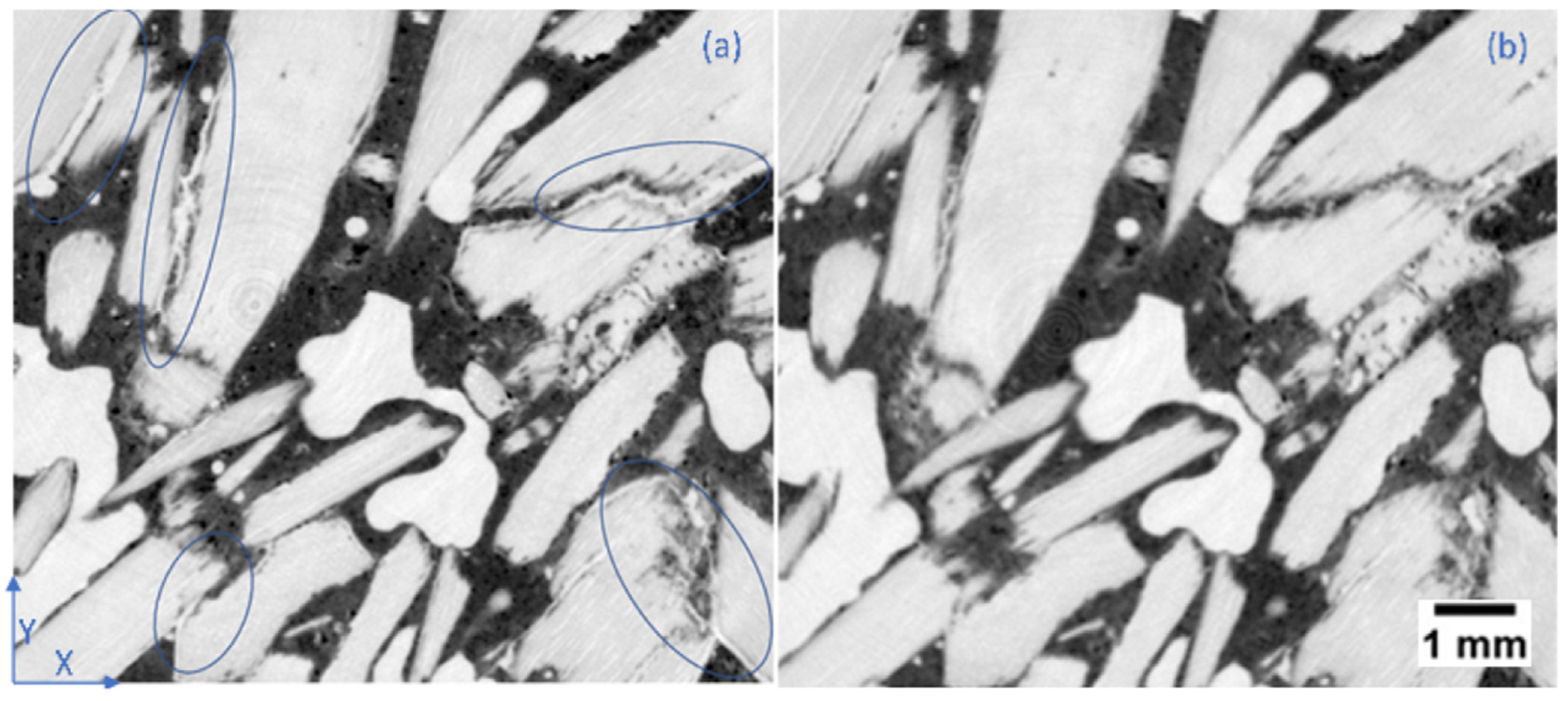
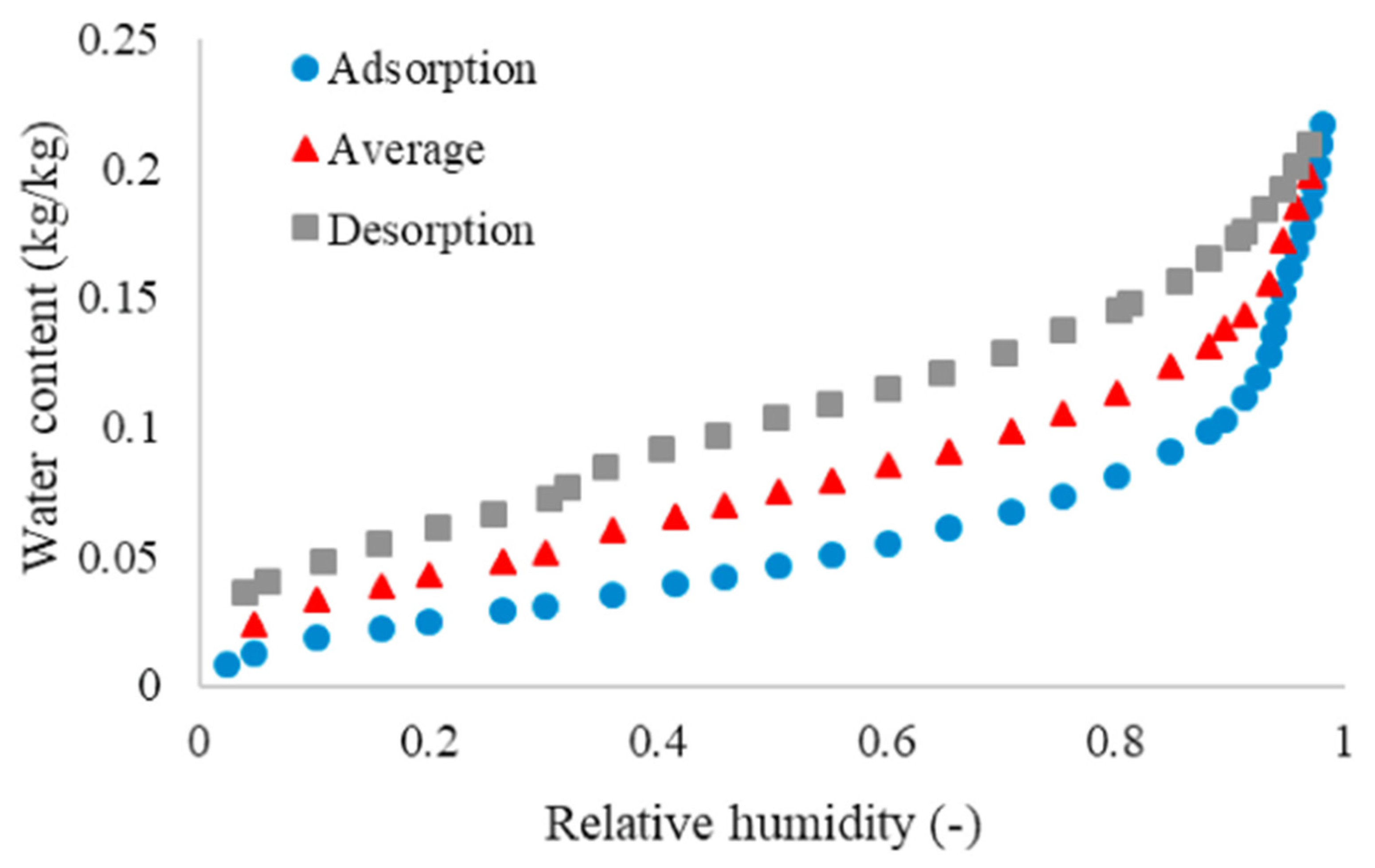
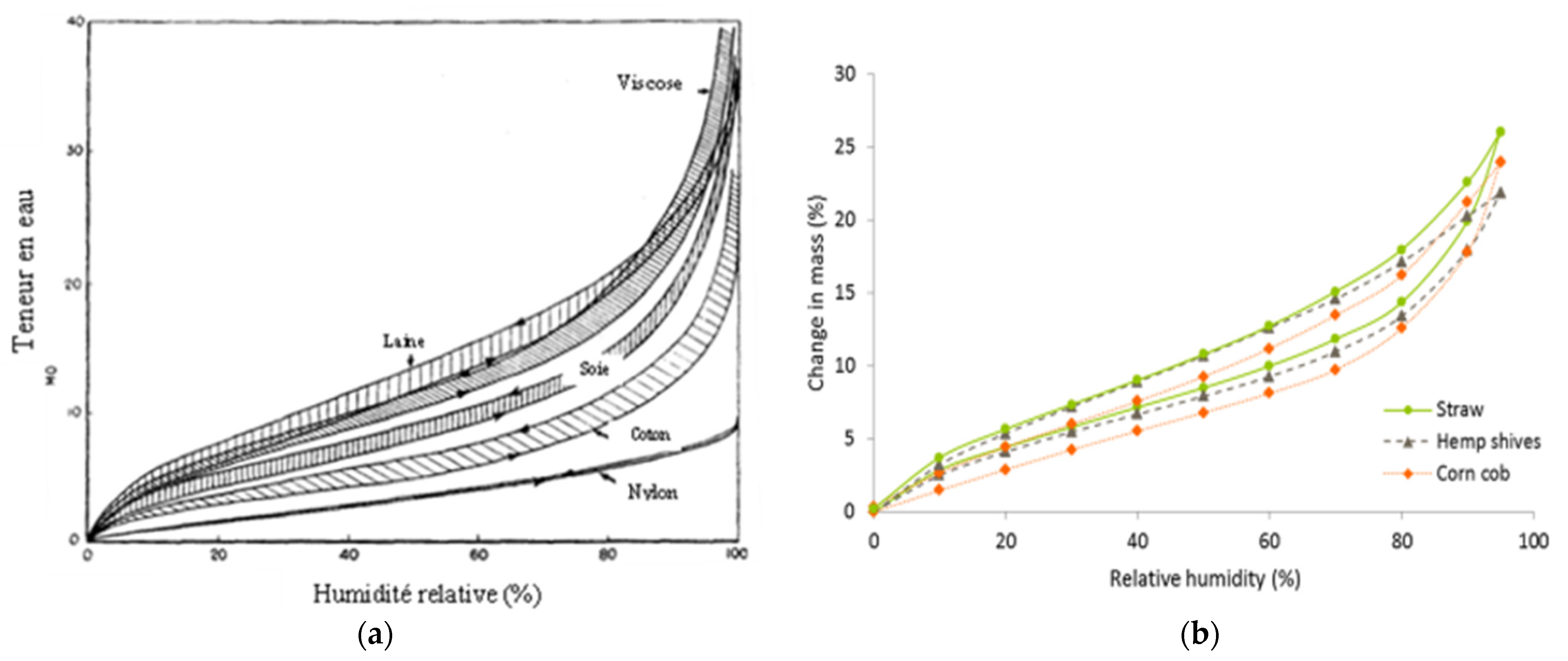

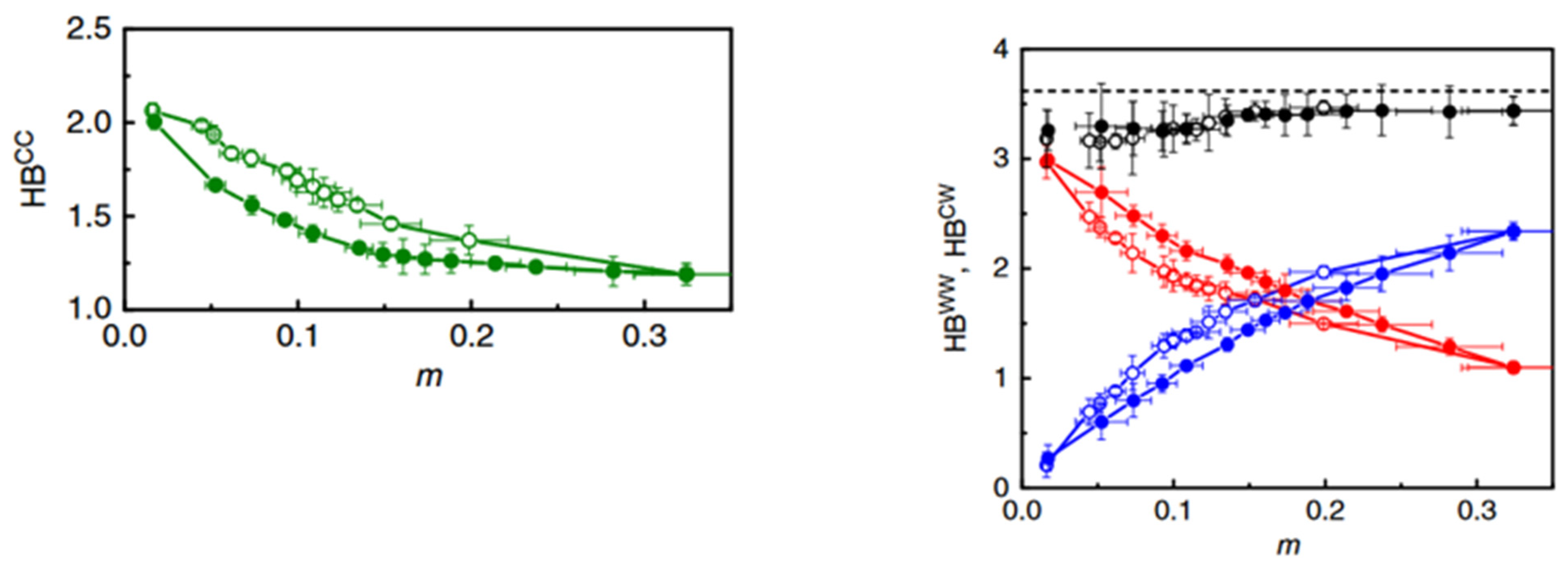
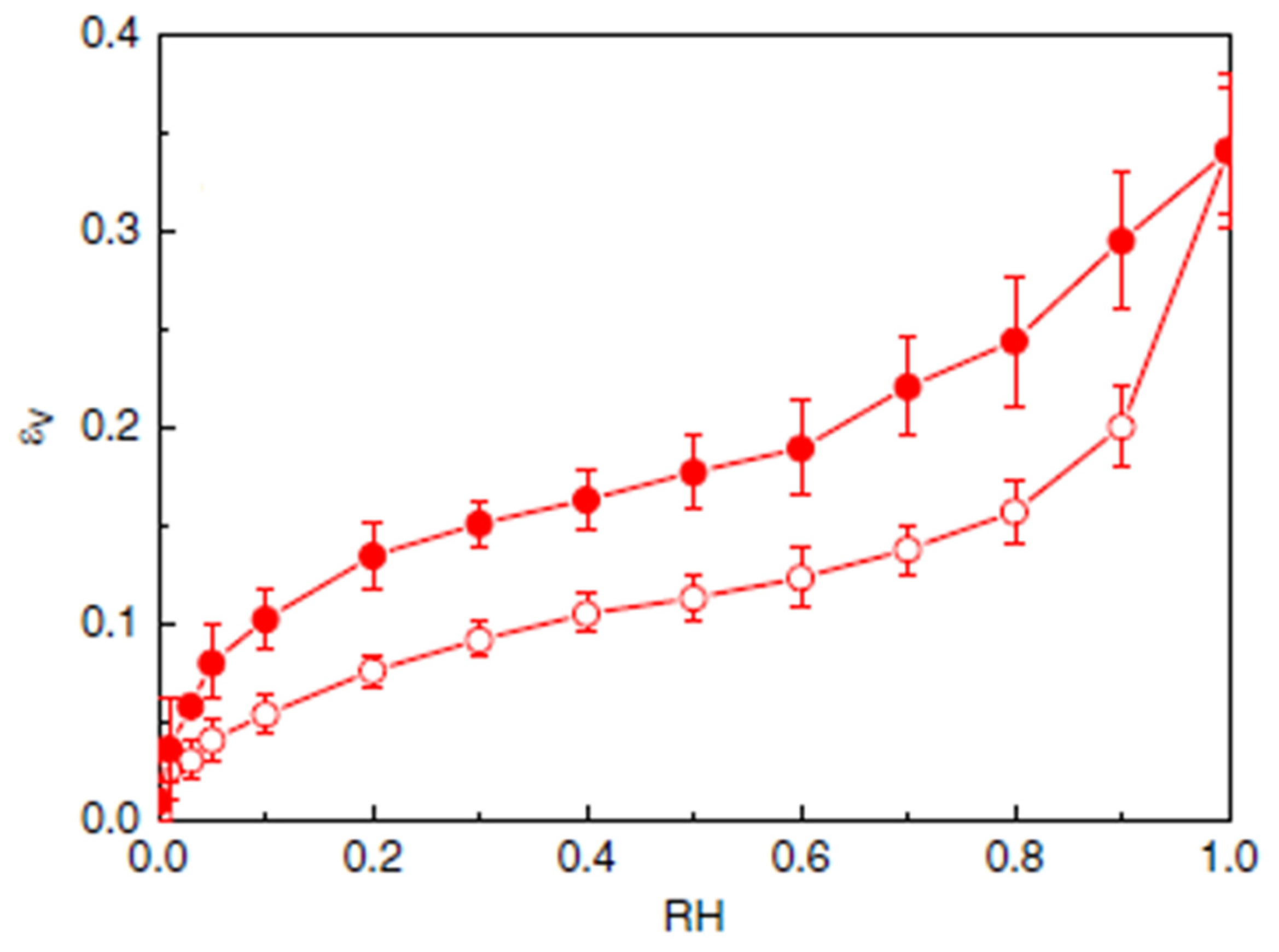
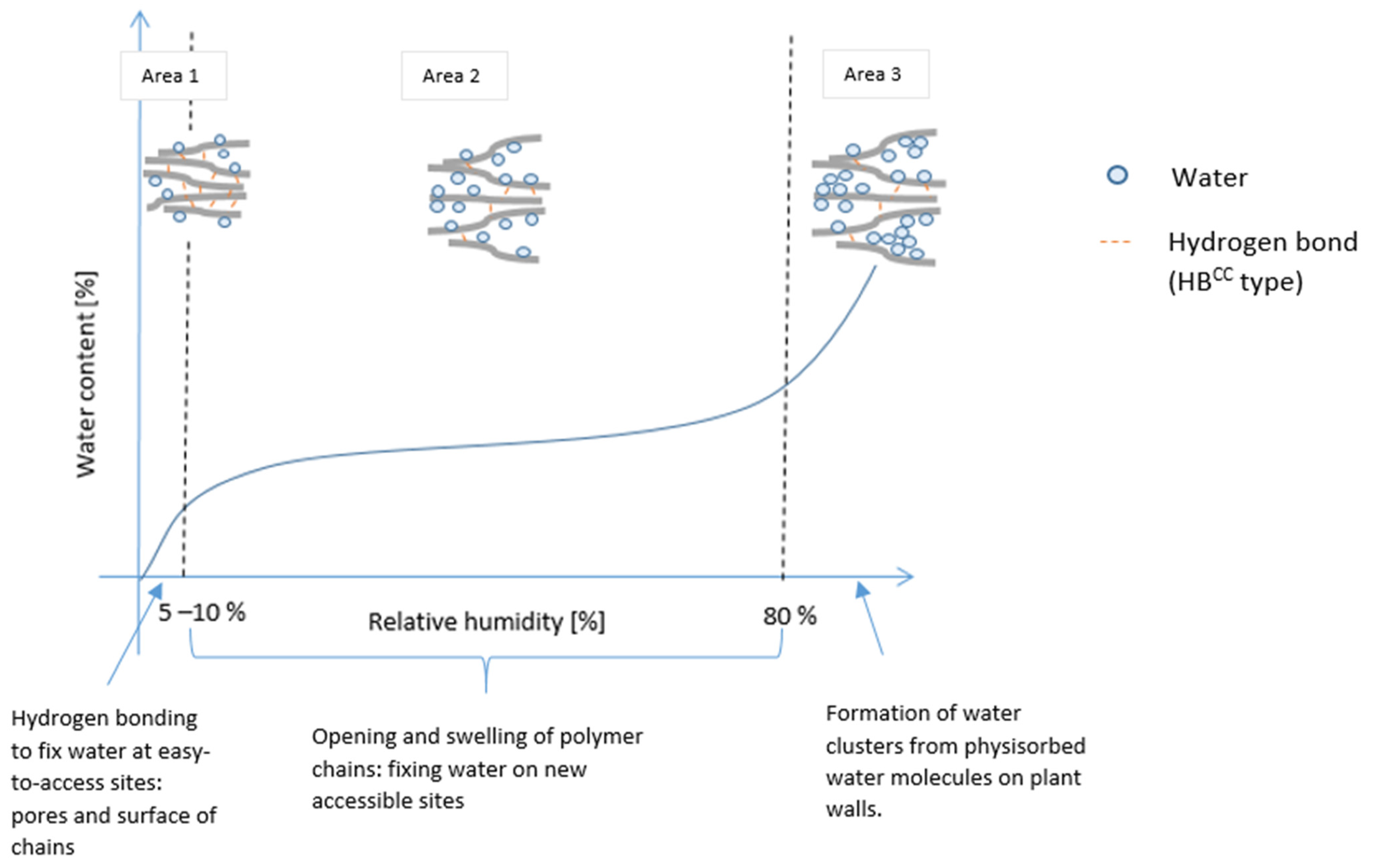
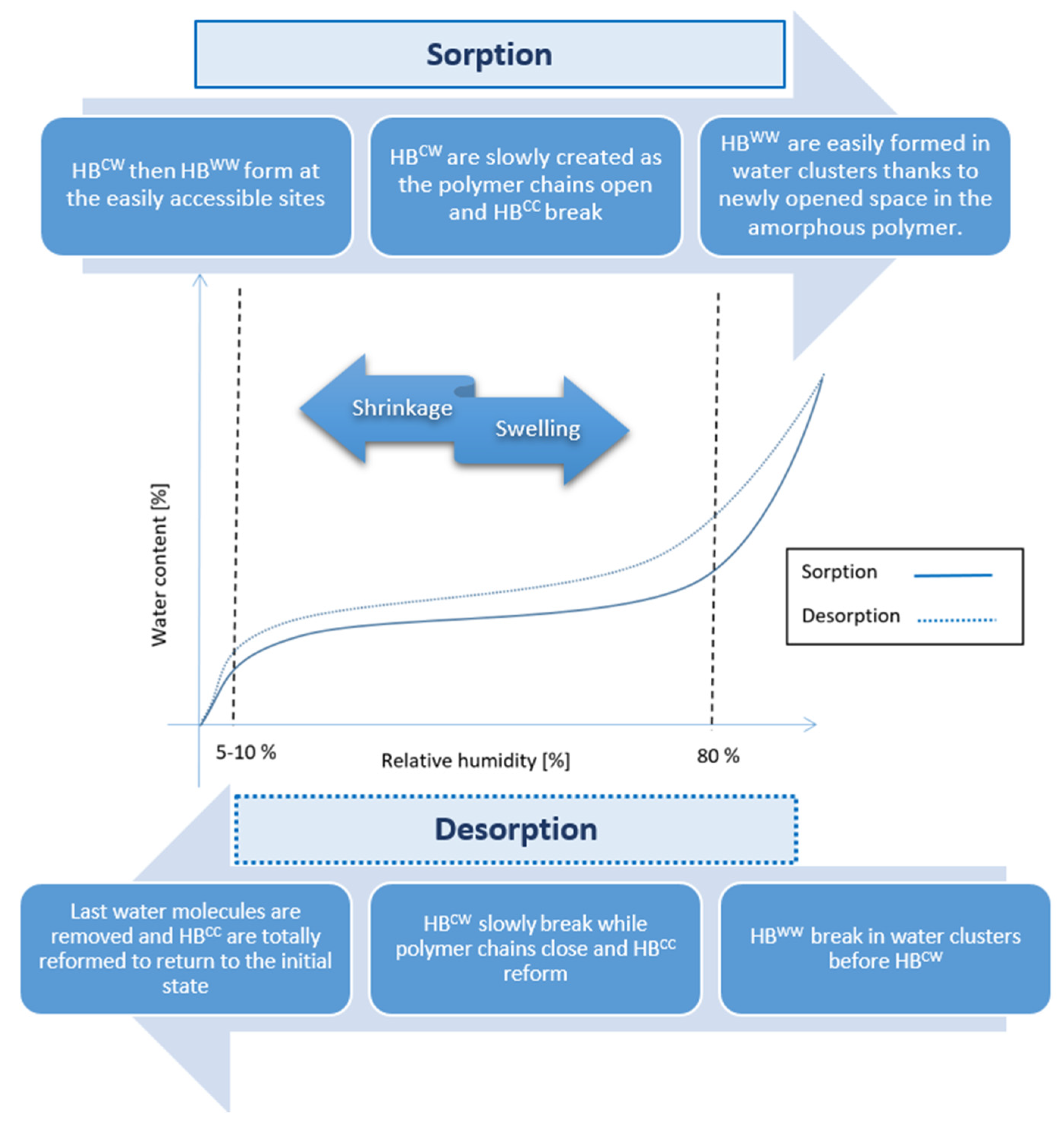
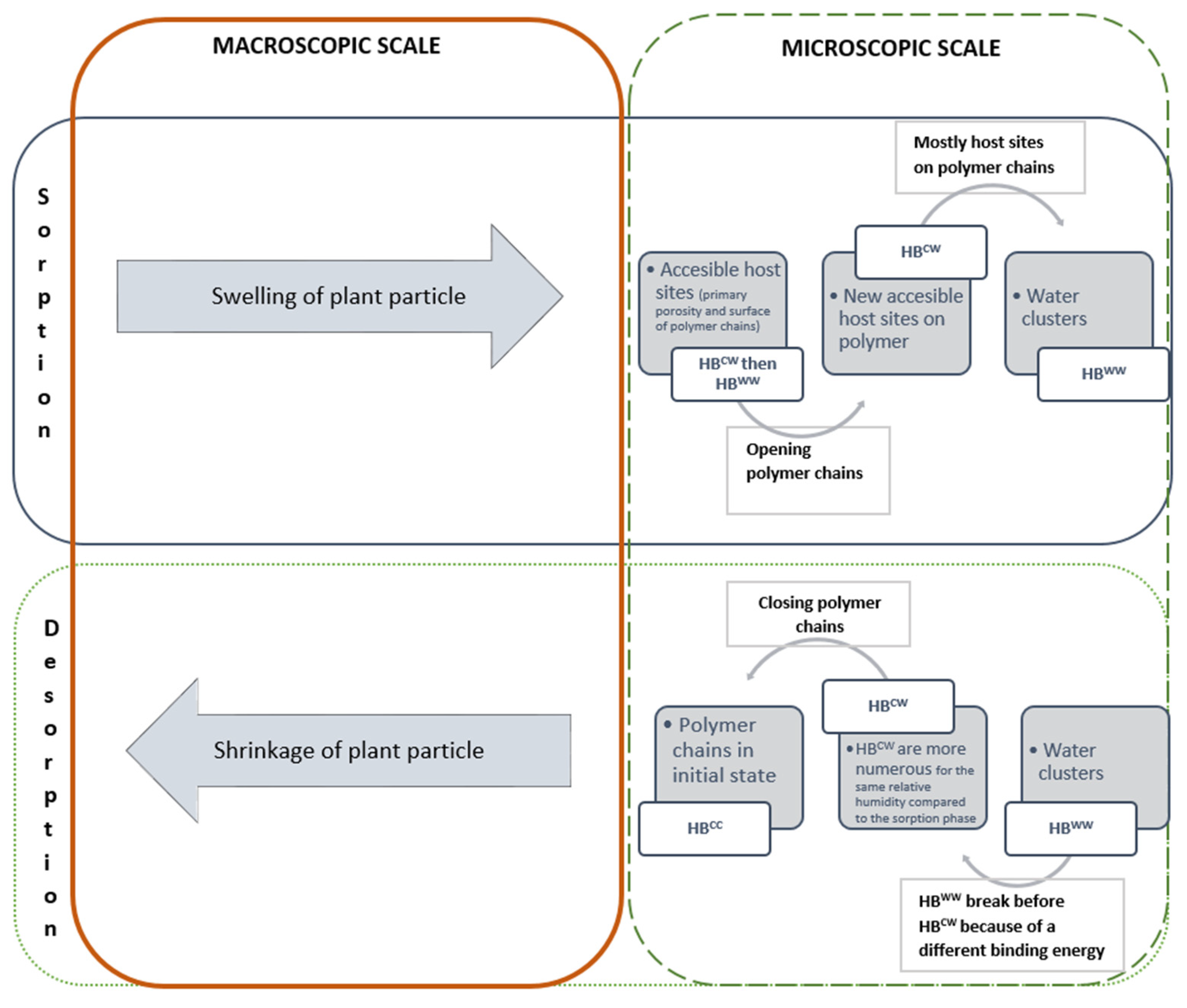
| Type of Bonding | Bonding Energy [kJ/mol] |
|---|---|
| Covalent | ≈100 |
| Hydrogen | ≈10 |
| Van der Waals | ≈1 |
| Volume V of Particleboard (cm3) | ||||
|---|---|---|---|---|
| Panel 1 | Panel 2 | Panel 3 | Panel 4 | |
| Dry state | 3123.1 | 2983.8 | 2433.93 | 2607.23 |
| 80% | 3347.1 | 3264.1 | 2578.7 | 2707.3 |
| Volume increase ΔV (%) | 6.7 | 8.6 | 5.6 | 3.7 |
| Observation | Origin | Explanation |
|---|---|---|
| Sorption mechanism is reversible. | Sorption–swelling coupling at the molecular scale in vegetal aggregate | Hydrogen bonds form and break easily, even at ambient temperature, due to their low binding energy. |
| Hysteresis is more pronounced for plant-based concrete materials than for aggregates. | Because of additional origins of hysteresis in material than in aggregate, the effects are cumulative. | |
| Aging reduces the rate of adsorption and desorption. | Residual water masks “host sites“: They are no longer accessible, as inhibited by the first sorption phase. | |
| Swelling of the plant particles or fibers during hysteresis is irreversible. | Returning to a dry state allows the last physisorbed water to be extracted. The intercellulosic chains seem to return to their original state. In any case, there is no (or negligible) macroscopic manifestation of swelling. | |
| Hysteresis increases, whereas crystallinity decreases. | The more amorphous the cellulose is, the more important the sorption–swelling coupling is. Interchain bonds cannot open in crystalline regions due to high stability. | |
| Swelling and shrinkage is observed at a young age or after a period of accelerated aging. | Swelling and shrinkage are possible as soon as HBCW replaces HBCC. This potential decreases with age (inhibited sites) but remains possible given the large number of host sites in the plant aggregate. | |
| There is temperature dependence of sorption curves. | Hydrogen bonding is temperature dependent. | |
| Relevance of considering local sorption kinetics in bio-based materials, especially when coupled with hysteresis. | The opening/closing of the cellulose chains is probably a rather slow process that needs a kinetic factor to be taken into account in both the sorption and desorption phases. | |
| Swelling is observed between the dry state and 80% RH. | The opening of the cellulose occurs from 5–10% to 80 % RH (cf. Figure 13). | |
| Water content is always higher in the desorption than in the sorption phase for the same relative humidity. | More water molecules are physisorbed during desorption because they do not have the same chemical potential. |
Disclaimer/Publisher’s Note: The statements, opinions and data contained in all publications are solely those of the individual author(s) and contributor(s) and not of MDPI and/or the editor(s). MDPI and/or the editor(s) disclaim responsibility for any injury to people or property resulting from any ideas, methods, instructions or products referred to in the content. |
© 2023 by the authors. Licensee MDPI, Basel, Switzerland. This article is an open access article distributed under the terms and conditions of the Creative Commons Attribution (CC BY) license (https://creativecommons.org/licenses/by/4.0/).
Share and Cite
Rosa Latapie, S.; Abou-Chakra, A.; Sabathier, V. Microstructure of Bio-Based Building Materials: New Insights into the Hysteresis Phenomenon and Its Consequences. Buildings 2023, 13, 1650. https://doi.org/10.3390/buildings13071650
Rosa Latapie S, Abou-Chakra A, Sabathier V. Microstructure of Bio-Based Building Materials: New Insights into the Hysteresis Phenomenon and Its Consequences. Buildings. 2023; 13(7):1650. https://doi.org/10.3390/buildings13071650
Chicago/Turabian StyleRosa Latapie, Séverine, Ariane Abou-Chakra, and Vincent Sabathier. 2023. "Microstructure of Bio-Based Building Materials: New Insights into the Hysteresis Phenomenon and Its Consequences" Buildings 13, no. 7: 1650. https://doi.org/10.3390/buildings13071650
APA StyleRosa Latapie, S., Abou-Chakra, A., & Sabathier, V. (2023). Microstructure of Bio-Based Building Materials: New Insights into the Hysteresis Phenomenon and Its Consequences. Buildings, 13(7), 1650. https://doi.org/10.3390/buildings13071650






